|
BIRTH OF KITTENS

HAVING KITTENS: FELINE PREGNANCY
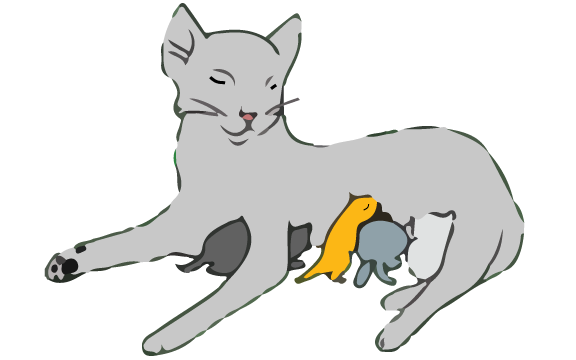
(original graphic by marvistavet.com)
Too often a litter of kittens comes as an almost total surprise. The cute little girl kitten from last fall is one day noticed to be a bit round in the middle only the very next spring. No one got around to spaying her and she seemed too young for – er - adult entertainment. Now we have a quandary: shall we have the kittens or not? It is not too late for spaying, even fairly late in pregnancy, and there is a spectacular over-population of cats. As tempting as it may be to extend the family with just one litter of kittens, please do not think of them as your grandchildren in feline form. There are plenty of adoptable feline grandchildren in the shelters and adoption groups so we encourage you to spay, even during established pregnancy.
That said, the rest of this web page concerns feline reproduction and neonatal care. We will assume you have decided to have the kittens anyway, finding them responsible homes or perhaps this was a planned breeding from the start.
For more details on the feline spay click here.
For the rest of the story, read on.
|
HOW THIS HAPPENED IN THE FIRST PLACE: BABY GIRL GROWS UP
Many people are surprised to find that the feline reproductive system is seasonal. Cats are designed to give birth only during warm months (spring through early fall). While not every female cat follows this rule to the letter, in general, cats are reproductively inactive when the days are short and begin their hormonal cycles annually when they perceive the days to be getting longer.
The female cat begins cycling when she has reached 80% of her adult size and when the days are appropriately long. This could be as young as 4 months of age. After age 7 or 8 years, cycles become irregular and there are more complications with birth so it is important to finish a female cat’s breeding career before this time.
|

Baby Girl
(Photocredit: Morguefile.com)
|
|
Indoor cats are sheltered from the light cycles of the sun and may not cycle as frequently as their outdoor counterparts. On the other hand, breeders who keep their cats completely indoors can manipulate the light cycle of the cattery so as to allow for year round cycling if desired.
PROESTRUS: This is the time in the cycle when the female begins attracting males but it is not yet receptive to their advances. Estrogen is building up and she is preparing for ovulation. The female is extra affectionate at this time, rubbing her head and sticking her rump in the air. She may also urine mark in the house and vocalize loudly and frequently. This period may be as short as 12 hours and as long as 2 days.
|
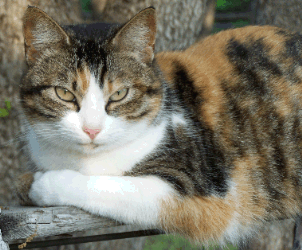
Grown Up Baby Girl
(Photocredit: Morguefile.com)
|
ESTRUS: The female cat’s behavior continues: rubbing, crying etc. but the difference here is that the male is accepted when he approaches. This behavior persists approximately 7 days (on the average) and during that time the female’s behavior is often objectionable to the owner. Contrary to previous belief, the act of mating does not shorten the estrus period (though it does substantially lengthen the time before the next estrus period). The female cat is ready to ovulate at this time but, in general, will not do so unless a male cat breeds her.
INTERESTROUS PERIOD: This is the period between times of behavioral estrus. If the cat is not bred or is bred and fails to ovulate, this time period is 8-10 days on the average. This means that the yowling, rubbing, urine marking, and other estrous behaviors continue for about a week, then discontinue for about a week, then begin again, back and forth all spring and summer and into the fall until the cat is either bred, spayed, or perceives the coming of winter. This behavior of the mature female cat is often all the motivation it takes for an owner to get her spayed even if she is completely confined indoors and has no chance of unwanted pregnancy.
DIESTRUS: If the female is bred and ovulates, she goes into this different reproductive stage. Her ovaries prepare for possible pregnancy and she will stay out of heat for at least 35-37 days even if she is not pregnant. If she is pregnant, she will carry her kittens for 64-66 days before delivering the litter. If for some reason, spaying is desired but must be delayed and yet the estrous behavior is driving the owner crazy, she may be fooled into thinking she has been bred through manipulation with a rectal thermometer. If you are interested in this procedure, contact your veterinarian as it is not as simple as it may sound but is often effective in providing peace at home.
|
HOW THIS HAPPENED IN THE FIRST PLACE, PART II: THE LOVERS
The female cat in estrus is a flirtatious creature. She seeks territory that has been urine marked by the male of her choice. (If the breeding is planned, it is generally best to bring the female to the male’s territory to approximate the natural situation). She approaches the male, rubbing, nuzzling etc. If she is in a receptive period of her cycle, she will allow him to bite the nape of her neck and will give him about 30 seconds to complete his sexual act. She typically yowls loudly during this time. The female immediately becomes “refractory” and attacks the male who backs off to wait for another chance. The female after-reaction to breeding involves obsessive rolling around on the ground and vaginal licking. After a few minutes, she is ready for more and will indicate this by more rubbing on him or patting gently at him. With each breeding, the time until the next attempt grows longer but may continue all day long.
|
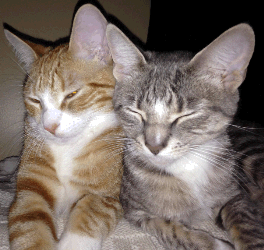
The Lovers
(Photocredit: Morguefile.com)
|
|
DIAGNOSIS OF PREGNANCY
The owner may notice that the unspayed female is rounder than usual and that her nipples have become prominent (called “pinking up”). This may not be noticeable until well into advanced pregnancy depending on how observant the owner is, how large the litter is etc. There are several ways to confirm feline pregnancy:
|
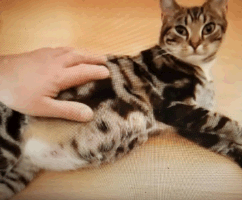
(Photocredit: CatMan via YouTube)
|
- Blood test: The Witness Pregnancy Test is approved for both canine and feline use and can be performed in about 15 minutes at your vet’s office. She must be about 30-35 days into the pregnancy for this.
- Ultrasound: Ultrasound can readily confirm pregnancy at approximately 22-25 days of pregnancy but is not readily available in all animal hospitals. Ultrasound cannot accurately determine how many kittens to expect and this is important information best obtained with a radiograph later on. Ultrasound can, however, be used to determine the delivery date for the kittens via measurement of the head and body.
- Radiology: At about 45 days of pregnancy, the kittens will have mineralized their skeletons and be visible on an x-ray. This is the only procedure that reliably can determine how many kittens to expect.
- Palpation: some veterinarians are talented enough to feel the developing kittens between days 17 and 25.
CARE DURING PREGNANCY
The female cat has relatively few needs during pregnancy. She will need a food that is approved for growth (i.e. a food appropriate for kittens) as she will need the extra calories, particularly after delivery when she is nursing. Her metabolic demand during nursing will triple and she will need the extra calories especially then.
Flea control is important during pregnancy as flea anemia is one of the leading causes of death in neonatal kittens. To find an appropriate flea product approved for use in feline pregnancy click here.
Do not vaccinate the pregnant cat.
Hopefully, her vaccinations were current prior to pregnancy. Developing kittens are vulnerable to live viruses used in modified live virus vaccinations, feline distemper in particular. The female cat either infected in pregnancy or vaccinated with live virus during pregnancy can produce kittens with a specific birth defect called “Cerebellar hypoplasia” a brain malformation that leads to tremoring and wobbling particularly when the cat is attempting a specific task (the so-called “intention tremor.”)
Most mother cats will seek their own nesting area in the last week or so of pregnancy. If you wish to help her, expect her to require soft bedding, an area with minimal human traffic and separation from other pets in the home.
|
LABOR
Several hours (and perhaps a whole day) of restlessness, grooming, nesting, pacing, panting, vomiting, and crying indicates that labor has begun. Like the dog, there is often a drop in body temperature ( to less than 99 degrees F) indicating contractions will commence in the next 12-36 hours but this is not as reliable a finding as in the female dog. The female cat secludes herself in her selected nest area and begins to purr.
The above first stage of labor with the initiation of hard contractions and the birth of a kitten. The third stage of labor refers to the passing of the placenta. The entire litter is born usually within 6 hours with kittens every 30-60 minutes. If she is stressed or distracted she is able to stop her labor and restart the next day. The new mother usually eats the placenta and membranes of the kitten’s sac. There is no special benefit to this behavior so if one wishes, one may remove these tissues from the nest and prevent her from eating them if one wishes but if you plan to cut the umbilical cord so as to disconnect the kitten from the placenta, be careful not to tug on the umbilical cord as this can damage internal organs of the baby. Do not attempt to move her and the kittens to a “better” nest spot after labor has started. This may stress her into curtailing her labor or worse may scare her into neglecting the litter.
|
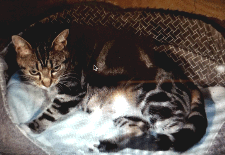
(Photocredit: CatMan via YouTube)
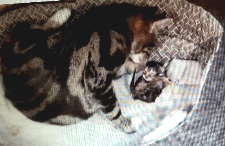
(Photocredit: CatMan via YouTube)
|
Strong contractions for more than 60 minutes without production of a kitten
indicates she needs help and should see the vet right away.
|
Most of the time labor is normal and goes off without a hitch. Kittens may begin solid food around age 4 weeks of age and may be adopted to new homes at age 8 weeks.
|
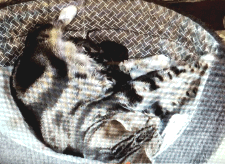
(Photocredit: CatMan via YouTube)
|
|
Vaginal discharge is normal for up to 3 weeks post-partum. This discharge is typically black or reddish and consists mostly of old blood. If the discharge seems particularly bloody, have the vet assess her blood loss. If the discharge looks like pus, she may have a uterine infection. Bring her to the vet; she may need to be spayed right away.
|
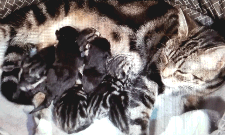
(Photocredit: CatMan via YouTube)
|
|
COMPLICATIONS SURROUNDING LABOR AND PREGNANCY
Vaginal Bleeding: Vaginal bleeding during pregnancy is not normal and suggests that she is aborting the litter. If this is occurring late in pregnancy (the 8th week) she may be delivering the litter prematurely and a cesarean section is likely necessary. In either case, have the vet check her to assess the blood loss and decide what to do.
Dystocia: If she has been having strong contractions for greater than 60 minutes, she needs assistance in passing the kitten. Bring her and any kittens delivered to the vet’s office right away.
Retained Placenta/Metritis: If the mother cat retains a placenta , she can develop an infection, fever, appetite loss, and kitten neglect. If this occurs, she will need to see the vet right away, possibly be hospitalized and will probably need to be spayed to remove the infection.
|
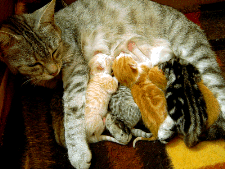
(Photo Credit: Hwman at the German Language Wikipedia via Wikimedia Commons)
|
Neonatal Isoerythrolysis: If the mother cat has Type B blood and the kittens have Type A blood, antibodies in the mother's milk will destroy the kitten's red blood cells. This is only preventable if one knows the blood type of the mother cat in advance (most cats are Type A but certain breeds commonly have Type B blood). Kittens in this situation can be saved if they do not nurse from their natural mother. For more information about this condition click here
|
GETTING HER SPAYED AT LAST
Many people are surprised by their cat’s pregnancy, do not really want the kittens, but, since she is pregnant, choose to go ahead with the litter with the intention of spaying when the kittens are weaned. The female cat may have other plans. Nursing the litter generally suppressed the return to cycling but the average female cat is back in heat about a month after delivery of the litter. If she has access to a male cat, she will likely become pregnant before she is finished weaning the current litter.
|
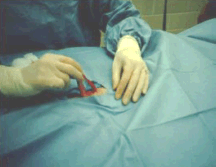
(original graphic by marvistavet.com)
|
Ideally, she should be confined until she can be spayed and ideally she should be spayed a month or so after the kittens have stopped nursing. The reason for this is to allow the mammary tissue to “dry up” and go back to a more normal, less vascular state. Spaying the female while her glands are still full leads to more bleeding and a more difficult surgery. If the choice comes down to spaying her with mammary development versus having an unwanted litter, however, spaying is a better choice.
|
RAISING ORPHANS
Sometimes one is faced with a litter that is too large for one mother cat to handle or disaster may strike leaving the kittens motherless. For full instructions on what to get and do in order to successfully raise a litter of kittens, click here.
|
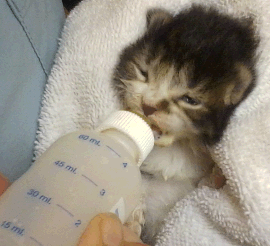
(original graphic by marvistavet.com)
|
|
WHEN THE MOTHER CAT IS FERAL
A feral animal is a member of a domestic species (such as a cat) who is living wild. If kittens are captured prior to age 10 weeks, they can usually be tamed and become normally socialized to human contact. After this age, socialization is much more challenging. Feral adult cats are often best left living in the wild world despite its hazards. This does not mean that they should be allowed to freely reproduce, however. "Trap-Neuter-Release" is a program that allows for humane management of a feral cat colony and has become official policy in many communities. For information on how to care for a feral cat colony appropriately, contact the Feral Cat Caretakers or visit their web site at www.feralcatcaretakers.org or www.straycatalliance.org. (In areas outside of Los Angeles, contact your local Animal Regulation Department for feral cat groups in your area).
To purchase live traps visit:
www.wildlife-traps.com
|
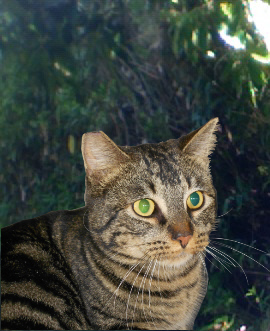
Local feral cat sterilization programs
commonly involve removing the tip of
an ear to designate a cat as neutered.
(original graphic by marvistavet.com)
|

Page last updated: 5/1/2022
|